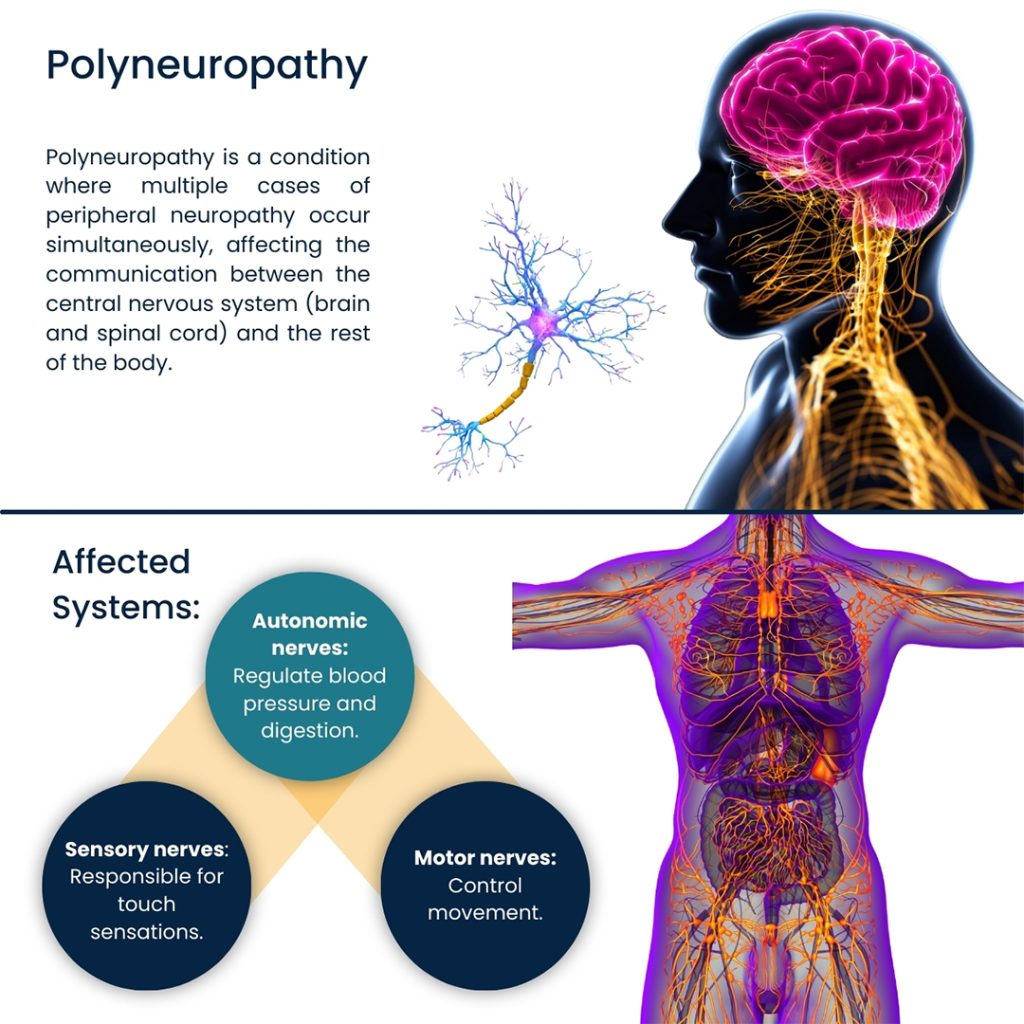When you have a condition like diabetes or HIV, you often experience a slew of unintended consequences, particularly if you don’t stay vigilant with your treatment plans. One of the risk factors of letting your disease progress is polyneuropathy, a painful nerve condition that affects several areas of your body at the same time. Polyneuropathy treatments, such as spinal cord stimulation, relieve your painful symptoms. Visit Pain Management NYC in New York City for the most effective treatment for polyneuropathy, as well as the diagnostic tools to help you uncover the cause of your nerve pain.
What Is Polyneuropathy?
Polyneuropathy refers to a condition that happens when more than one case of peripheral neuropathy, occurs at the same time. Peripheral nerves send messages between the central nervous system — the brain and spinal cord — and the rest of your body.
Polyneuropathy can affect any number of systems simultaneously, including:
- The autonomic nerves, responsible for everything from your blood pressure to digestion
- Sensory nerves that trigger touch
- Nerves that control movement
Polyneuropathy typically is a symptom of an underlying problem, rather than a disease in and of itself. As polyneuropathy can have several causes, you need to seek medical care as soon as possible for an accurate diagnosis and proper polyneuropathy treatments, such as spinal cord stimulation. In New York City, experienced and skilled polyneuropathy specialists are at Pain Management NYC.
These doctors offer treatment for polyneuropathy, as well as diagnoses and treatments for a wide range of nerve disorders, such as:
- Carpal tunnel syndrome
- Small fiber neuropathy
- Neuropathy in feet and hands
- Complex regional pain syndrome (CRPS)
- Tarsal tunnel syndrome
- Headaches and migraines
- Peroneal nerve damage

What Are the Symptoms of Polyneuropathy?
The symptoms of polyneuropathy differ depending on the nerves affected and how long you’ve suffered from the discomfort.
Polyneuropathy symptoms may come on suddenly or gradually; common signs and symptoms include:
- Tingling and numbness, often occurring in the limbs
- A continuous burning sensation in affected areas
- Sharp or stabbing pain, which is generally worse at night
- Muscle weakness, particularly in the limbs, impairing movements such as gripping, lifting and walking
- Impaired coordination and balance, increasing the risk of falling
- Hypersensitivity to touch, which causes pain or discomfort even with light pressure
- Difficulties performing fine motor skills tasks, such as buttoning your shirt or tying shoelaces
- Problems with blood pressure, heart rate and bowel or bladder functions
Polyneuropathy symptoms can become more severe when left untreated and affect several bodily functions.
Some potential complications and symptoms that may arise if you don’t receive effective polyneuropathy treatment include:
- Muscle weakness and atrophy, particularly in the limbs that develops over time
- Long-term nerve injury that results in muscular wasting
- Reduced ability to detect pain, temperature and touch
- Joints that become distorted because of muscle weakness
- Injuries due to inflexibility of your joints and imbalance
What Causes Polyneuropathy?
The cause of polyneuropathy is frequently unknown and called idiopathic. A variety of factors can cause polyneuropathy, and it’s often the result of a combination of them. So seek treatment and diagnoses from an experienced polyneuropathy specialist.
The most common causes include:
- Diabetes. High blood sugar levels over an extended period damage nerves throughout your body, leading to diabetic neuropathy.
- Hypothyroidism. This condition involves an underactive thyroid.
- Infections caused by viruses or bacteria. HIV, herpes simplex and varicella-zoster are viruses. Lyme disease is caused by bacteria.
- Guillain-Barré Syndrome. This is a condition in which your immune system attacks the nerves.
- Chronic inflammatory demyelinating polyneuropathy. This is an autoimmune disorder that affects peripheral nerves.
- Nutrition deficiencies. Polyneuropathy may be caused by vitamin and mineral deficiencies, particularly B vitamins and vitamin E.
- Diseases of the liver. Chronic renal disease and other liver problems can cause polyneuropathy.
- Malignancies. Particular malignancies like those affecting the nervous system can cause polyneuropathy.
Polyneuropathy is diagnosed by your polyneuropathy specialist following a thorough evaluation, including a detailed medical history, physical examination and several diagnostic procedures.
A common diagnostic process at Pain Management NYC includes:
- Detailed information on the symptoms you’re experiencing, such as when they started and when they’re most painful
- A complete medical history, family history and information about various lifestyle factors
- Neurological function that’s evaluated thoroughly, including muscle strength, reflexes, coordination and sensory perception
- Testing for diabetes, vitamin deficiencies, autoimmune disorders, infections and inflammatory markers
- Nerve conduction studies and electromyography, which are electrical signal tests that assess nerve and muscle function
- Imaging tests such as MRI or CT scans to rule out structural problems or nerve compressions
- Lumbar puncture to look for symptoms of inflammation, infection or other abnormalities in the central nervous system
- Testing for specific mutations if genetic factors are suspected
- Assessing the density of nerve fibers in the skin, particularly when short-fiber neuropathies are suspected
- Quantitative sensory testing to assess your ability to perceive sensory stimuli, which is another test that’s effective in the diagnosis of small fiber neuropathy
What’s the Treatment for Polyneuropathy?
Which polyneuropathy treatment is determined to be the best course of action for you depends on the underlying cause and specific symptoms you have. It’s vital that you receive treatment for the underlying disease causing the neuropathy to avoid more nerve damage and to improve or eliminate your symptoms.
A general approach to treatment for polyneuropathy includes:
- Managing underlying conditions. This includes managing autoimmune diseases, maintaining blood sugar levels if you’re diabetic and promptly treating infections. Your polyneuropathy specialist provides the necessary treatment or makes a referral for other treatment that may run concurrently with your polyneuropathy treatments.
- Undergoing pain management. To manage neuropathic pain, medications such as pain relievers, anti-seizure drugs and antidepressants, as well as topical treatments such as creams or patches, may be used. Nerve blocks that target the specific sources of pain provide exceptional relief while you undergo treatment of the underlying cause of your nerve pain.
- Taking supportive measures. Proper foot care is important for preventing injuries and infections, especially if you suffer from decreased sensation. To promote mobility and prevent injuries, a cane, orthotic devices or braces may be advised.
- Participating in physical therapy. It can aid in the improvement of muscle strength, balance, and coordination. Range-of-motion exercises may be advantageous as well to keep your joints flexible and pain-free.
- Providing nerve stimulation. To treat pain, your doctor may use transcutaneous electrical nerve stimulation (TENS) or other nerve stimulation procedures, such as spinal cord stimulation or peripheral nerve stimulation.
To prevent polyneuropathy and the pain that accompanies it, maintain good general health by:
- Managing chronic illnesses
- Eating a balanced diet rich in vitamins
- Exercising regularly to enhance circulation
- Limiting alcohol use
- Avoiding pollutants, including nicotine
- Maintaining appropriate posture
- Treating infections promptly
- Getting regular checkups from your polyneuropathy specialist to catch potential risk factors
To receive an accurate diagnosis and effective treatment for polyneuropathy, contact Pain Management NYC, one of the few practices in New York City with doctors who are both certified and experienced in finding the true cause of your pain and delivering excellent service to relieve your suffering so that you can return to a pain-free life.

Boleslav Kosharskyy, MD, is a top-rated, best-in-class interventional pain management doctor. He is board-certified in Anesthesiology, Interventional Pain Medicine, and Palliative Care.
Dr. Kosharskyy is an Associate Professor of Anesthesiology and Rehabilitation Medicine at Albert Einstein Medical College. He’s also the Associate Medical Director of Pain Medicine and Director of Anesthesia for the Joint Replacement Center at Montefiore Medical Center and Albert Einstein Medical College.
He is an active member of the American Society of Anesthesiology (ASA), the American Society of Regional Anesthesia and Pain Medicine (ASRA), and the New York State Society of Anesthesiologists (NYSSA)
